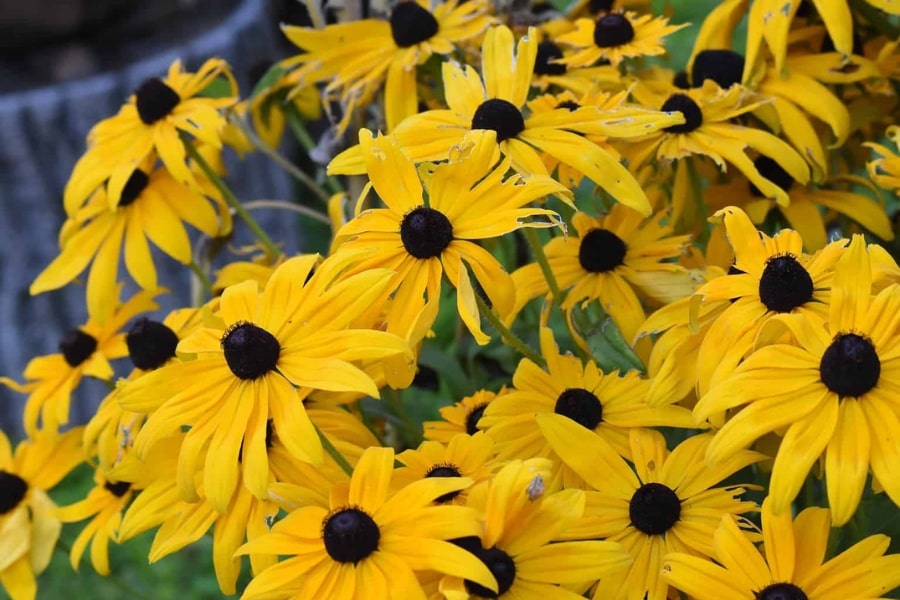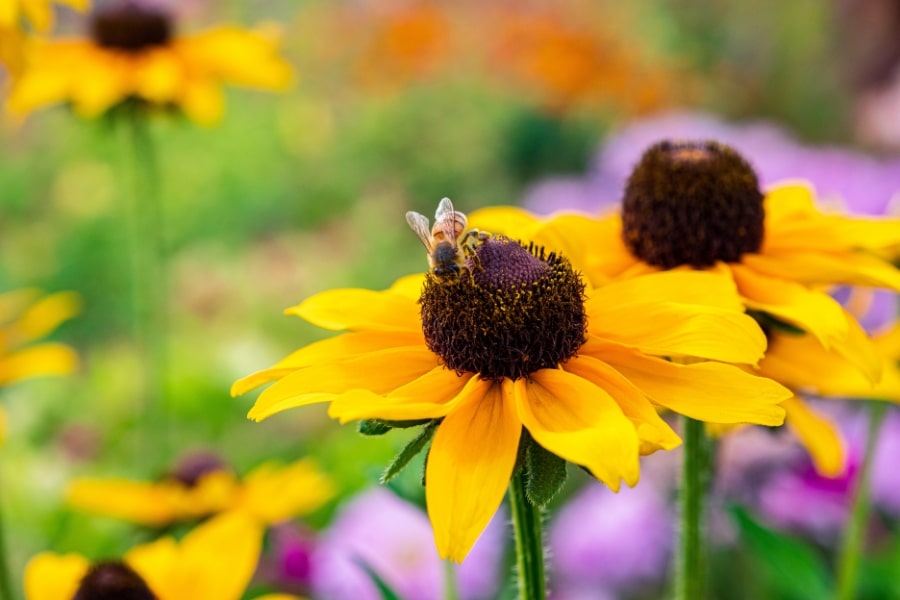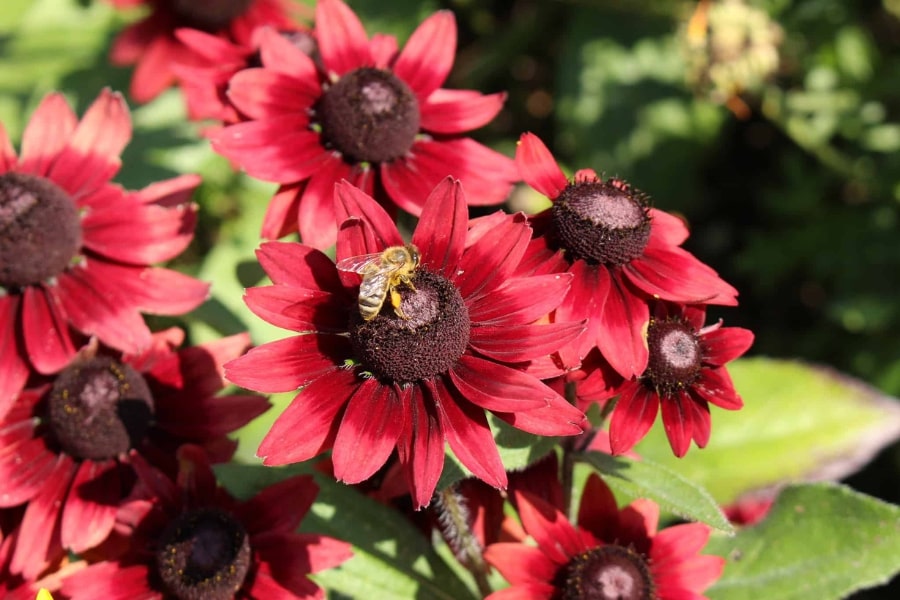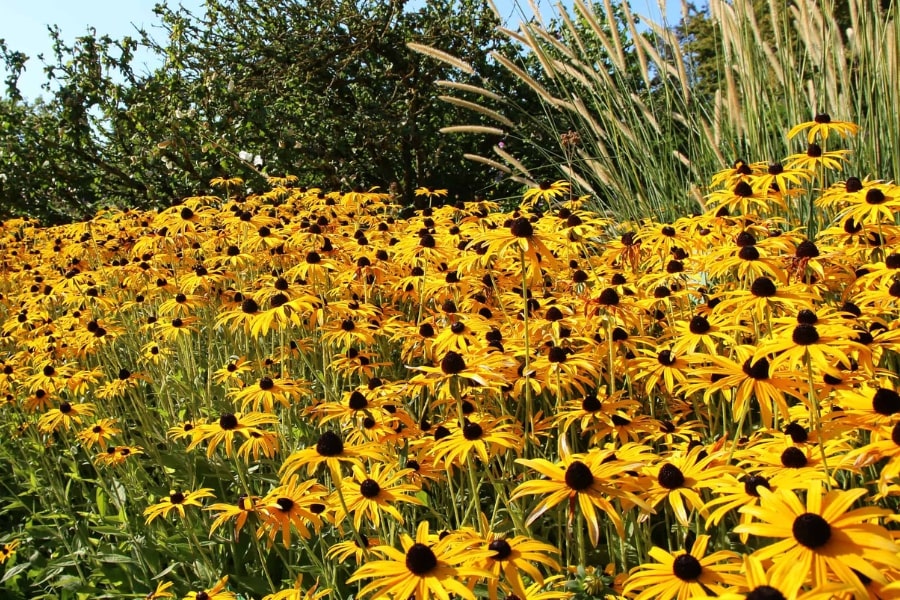Rudbeckia, also known as Black-Eyed Susan, is a genus of flowering plants in the Asteraceae family. The word “Rudbeckia” pays homage to Olof Rudbeck the Younger, an esteemed Swedish botanist from the 17th century. Rudbeckias come in many sizes, from compact varieties suitable for containers all the way up to tall, dramatic selections that command attention in larger landscapes.

Our Selection of Rudbeckia
At Martin Garden Center, we grow Black-Eyed Susan in 4″ containers and we also re-stock from our local vendors. Often, we have 1-gallon containers as well. Because this species is a heat lover, we don’t tend to have it available till June, but we do attempt to keep it in stock till first frost as it is a very popular plant.
Varieties found at Martin Garden Center include the most popular Rudbeckia Goldstrum, as well as Indian Summer, American Gold Rush, Irish Eyes, Cherry Brandy, and Little Gold Star. From time to time, we will have varieties of the Brown-Eyed Susan, but these are less popular as they tend to be less attractive than their Black-Eyed Susan counterparts.
We are also growing the following varieties in 2025:
- Cherry Brandy
- Goldblitz
- Goldsturm
- Little Goldstar
- Sunbeckia
Growing and Caring For Rudbeckia
- Rudbeckia is a true sun lover; they thrive in full sun to light shade, preferring at least 6 hours of direct sunlight daily. Planting them in a location with ample sunlight ensures vigorous growth, sturdy stems, and vibrant blooms.
- Well-draining soil is crucial for Rudbeckias. They don’t tolerate waterlogged conditions, so make sure your compact clay soil has good drainage. A slightly acidic to neutral pH (around 6.0 to 7.5) is ideal. Amending the soil with organic matter, such as compost, can improve its texture and drainage, creating an environment where Rudbeckias can flourish.
- While Rudbeckias are drought-tolerant once established, consistent moisture is essential during their initial growth phase. Water newly planted Rudbeckias regularly to help them establish their root systems. Once established, water them deeply and infrequently, allowing the soil to dry out between waterings.
- These plants don’t require heavy fertilization. A balanced, slow-release fertilizer applied in early spring can provide all the nutrients they need for the growing season.
- As Rudbeckia produces new flowers, removing the old ones can redirect the plant’s energy toward further growth and blooms.
- Over time, Rudbeckias can become overcrowded and develop a less vigorous growth habit. Dividing the plants every 2 to 3 years in early spring or late summer can help rejuvenate them. Dig up the plant, separate the clumps, and then replant the divisions at the appropriate spacing.
- Rudbeckia is generally resistant to most pests and diseases and tends to be deer resistant. However, we do see issues from time to time with caterpillars and powdery mildew. Small holes in the leaves (usually late summer) are your first sign of caterpillars. Your solution is a simple spray with BT (Bacillus Thuringensis), an organic pesticide. Powdery mildew tends to show up when the autumn nights are cool and morning dew is found. Copper fungicide is an organic pesticide that helps prevent powdery mildew.

Leaves and Flowers
The leaves of Rudbeckias are usually deep green, lance-shaped, and coarsely textured. They form an attractive basal rosette that provides a lovely backdrop to the colorful blooms. The leaves play a vital role in photosynthesis, converting sunlight into energy to fuel the plant’s growth and flowering.
The flowers, however, are the stars of the show. Rudbeckia flowers are characterized by their distinctive appearance – a vibrant ring of golden or yellow petals encircling a dark, domed central disk. The contrast between the petals and the disk is visually striking and draws attention from afar. These flowers also serve as beacons to pollinators, attracting bees, butterflies, and even birds to partake in their nectar.

Black-Eyed Susan
One of the most iconic species, Rudbeckia hirta, features radiant yellow petals encircling a dark, almost mysterious central disk – hence the common name “Black-eyed Susan.” This species is native to North America and is often used in wildflower meadows, cottage gardens, and as a cut flower. It produces a profusion of bright yellow or orange flowers with a characteristic dark center from mid-summer to late fall. There are other species such as brown-eyed susan (Rudbeckia triloba) that are less common.

Frequently Asked Questions
Is Rudbeckia a Perennial?
Yes, Rudbeckia is a perennial plant. There are various species and cultivars within the Rudbeckia genus, commonly known as black-eyed Susans and many of them are perennials.
Is Rudbeckia Deer Resistant?
Rudbeckia is considered deer-resistant, deer are less likely to browse on them compared to more preferred food sources.
Is Rudbeckia Poisonous To Dogs And Cats?
Rudbeckia is not listed as harmful to Animals. However, ingesting large quantities of any plant material, even non-toxic ones, can still cause mild gastrointestinal upset in pets, leading to symptoms such as vomiting or diarrhea. If you suspect your pet has ingested a significant amount of any plant and is showing signs of illness, contact your veterinarian for advice.
